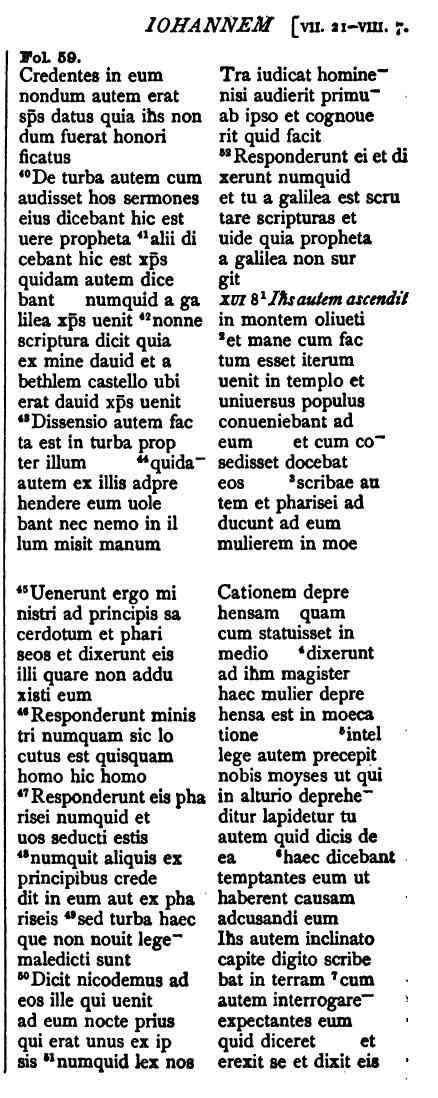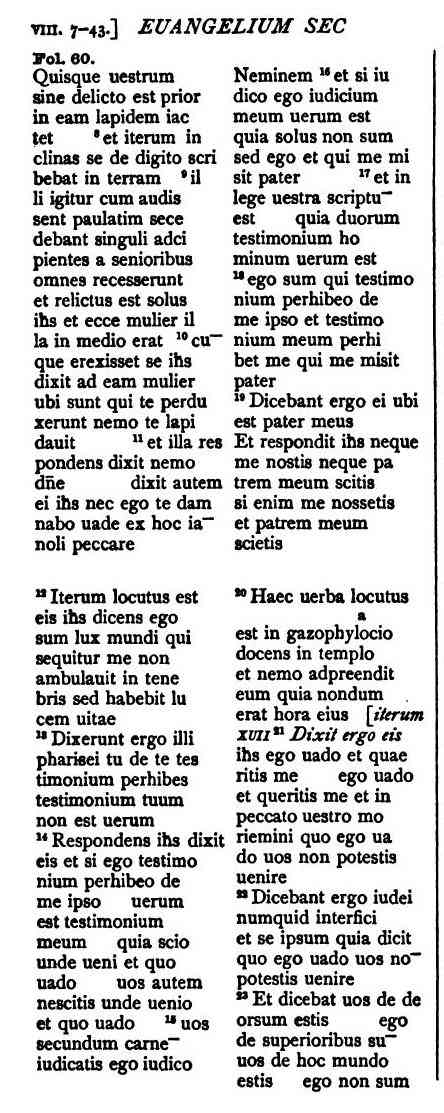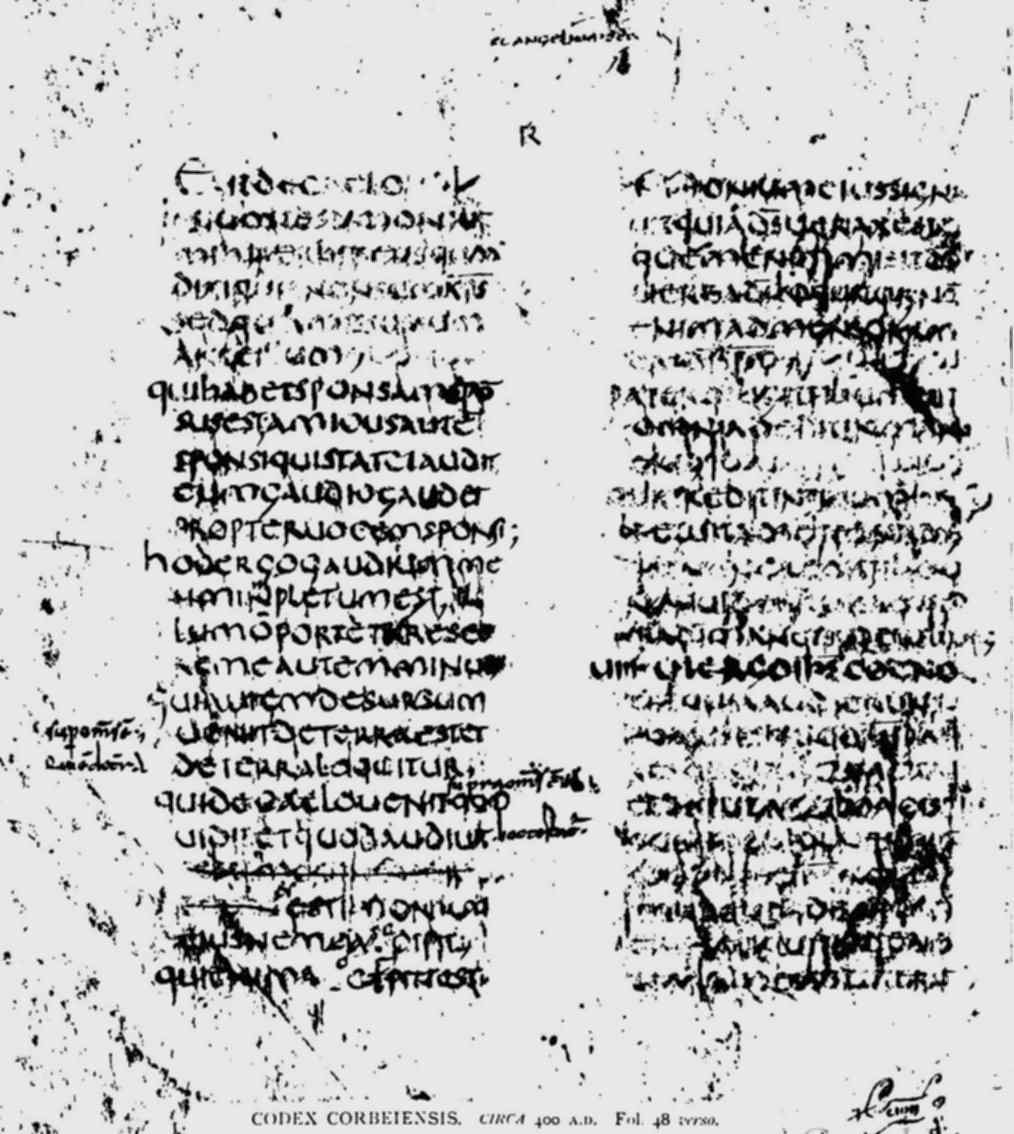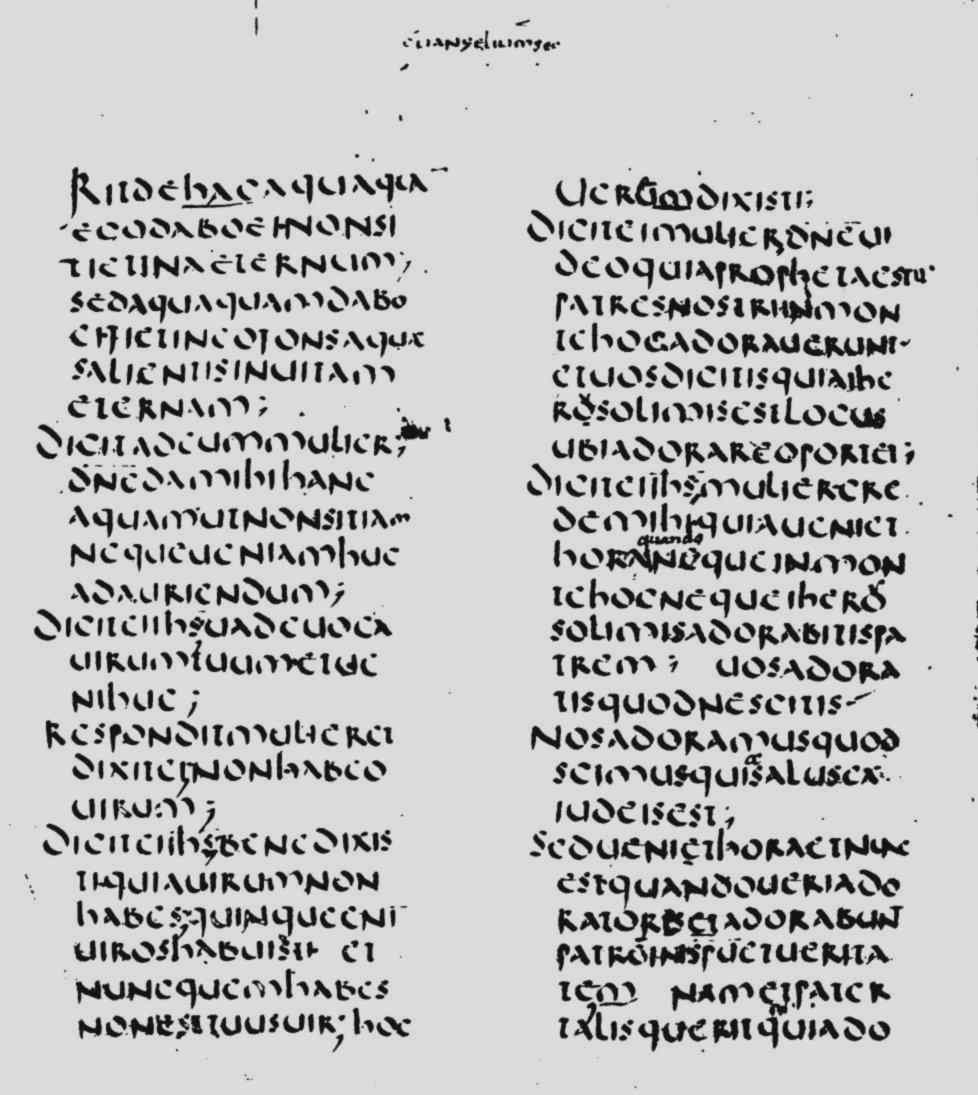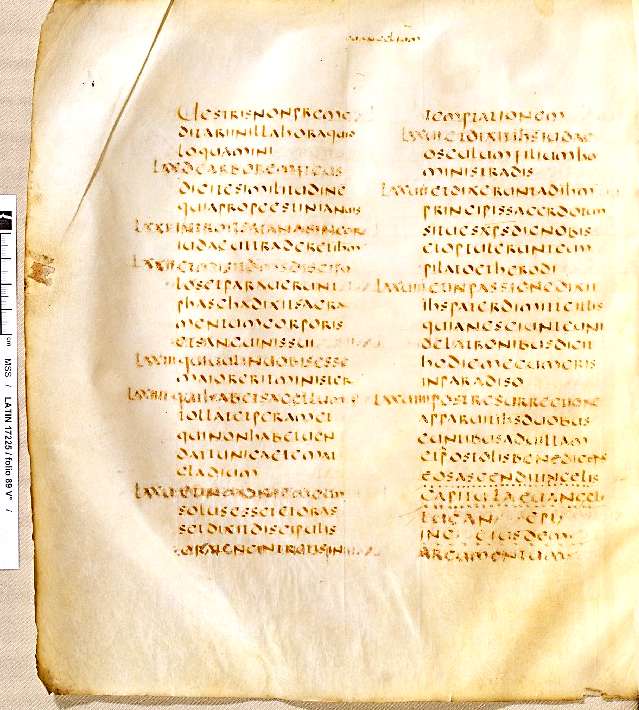Codex Corbeiensis:
Introduction
Introduction: Extract from Abridged Introduction
...This collation is the outcome of the critical sagacity of the late Samuel Berger, whose work in deciphering old Latin MSS (notably Le Palimpseste de Fleury) entitles him to the gratitude of all students of the Latin text of the New Testament.
The early history of the MS is involved in utter obscurity. The copyist left no record of his name or environment. His work shows him unacquainted with the Latin language.
The MS belonged anciently to the Beneditine Monastery of Corbey near Amiens -- once the home of many precious records of the early Christian ages. It entered in comparatively recent times into the Biblioteque Royale, whose red stamp it bears on its last page. It has now found a home in the Biblioteque Nationale, where it is numbered Lat. 17,225.
The Codex has lost 3 out of 8 quires in St. Matthew. (from beginning to Matt. 11:16). The first leaves seem most exposed to loss: e has lost its first five quires. Two leaves are missing from St. John containing 17:15-18:9 and 20:23-21:8 respectively. Three leaves are wanting in St. Luke: two of these were consecutive and contained 4:45-10:20; the 3rd contained 11:45-12:6. Happily St. Mark is complete except that three leaves, the last two and the 3rd leaf of quire 26 - are mutilated. The first to extant leaves of St. Matthew are also slightly mutilated.
...the vellum is exceedingly fine [thin], so much so that when photographed the letters on the other side appear through the vellum. Some pages...are as clear as when they left the copyist 15 centuries ago; but others are faded and only fully decipherable by observant study.
There are 2 columns of 24 lines on each page. ...Each vellum measures 28.5cm x 24.5cm, or 11 1/4" by 9 5/8 ", but originally was somewhat larger, having been clipped when bound. The binding is about 200 years old.
...Punctuation by the scribe himself is exceedingly rare. In the whole of St. Mark (except pointing of numerals) there are only five stops.
RE: the Captitula..there is good reason to believe that they did not form part of the master-copy, but were copied from elsewhere. ..
The paragraphs correspond with those in e. 5 out of 6 breaks in e's narrative are found in ff. The paragraphs in b and ff are almost identical.
Comparison of the palaeography of ff with other ancient Latin MSS has convinced the present writer that ff must rank with a in antiquity. Its is earlier than hacts or n, and also b. Many of the letters in ff resemble the uncials current in the 4th century. The "M" in ff is a replica of that in the 4th cent. Cicero Palimpsest at Rome, Pal.Soc. ii.Pl 160.
One cannot tabulate all the palaeolographical impressions of a MS, that lead to the belief that it is earlier or later than another. The great simplicity of the letters, the absence of all knobs or ornamental points, the smallness and plainness of the capitals, the straightness and thinness of lines marking abbreviations, the extreme rarity of punctuation -- all these contribute to the convictin that ff belongs to remote antiquity, and that it surpasses in age all other Old Latin MSS with the exception of a.
The Character of the Codex ff
There are two aspects: the character of the mastercopy and the character of the copyist.
The licence of Western scribes is almost proverbial, and has been used by Hort as a strong argument for dismissing as summarily as he has done the evidence of [all] the "Western" MSS. When e for example writes capharnaum for naim, and capharnaum also for corozain; confounds Cleophas and Cephas and alters the context accordingly, the student may well hesitate about accepting any singular readings of such a codex. A witness who distorts even a few facts impairs the value of his evidence as a whole.
The striking character of ff is the absence of any such errors as those just named. There are unconscious errors of transcription (as in all MSS); but of wilful alteration of the text from 'supposed fitness for immediate and obvious edification' there is, to the best of the present writer's belief, not a single instance.
The singular readings of ff are quite different in character from most of the singular readings of e, or even of b or k.
Another source of obliteration of readings is harmonization, from such compilations as the Diatessaron. Again, ff can be shown to be more free from this influence than any extant Latin or Greek MS [!].
Summary
Evidence for assigning ff to as early a date as 375-425 A.D. may be found in:
(1) The unfixedness of the spelling to a degree unparalleled in any other MS. Of this almost every page gives proof.
(2) The exceeding rarity of punctuation.
(3) The absence of all observance of the rules of grammar; and the persistence of vulgarisms in both grammar and spelling.
(4) The shape and form of the letters, especially of E T M O.
(5) The large amount of verbal variation from the Vulgate, especially in such well-known and often quoted verses as Matt.11:28, Lk. 2:14, Mk. 14:24.
(6) The comparative freedom of ff from the harmonizations found in other texts. [cf. Matt. 24:35, 27:34, Lk 3:21 6:31, Mk. 4:39, 14:24]
(7) The agreement of ff with the Old Syriac Version; and with Irenaeus and Origen in ancient readings lost in all other MSS.
The cumulative force of the evidence from these sources cannot be negatived by imputing to ff "the textual timidity of the 5th century". That the text of ff keeps on the whole nearer to the TR than do other ancient Old Latin MSS (with the exception of a) is a fact which must be recognised, but it determines nothing either for or against the antiquity of our MS or of its text. In this case, as in others, theories must be subserviated to ascertained facts. The large measure of support given by the two oldest Latin MSS a and ff to the TR is a fact which can no longer be neglected, especially when it is remembered that "the text has been preserved with less alteration in the versions than in the MSS".
The reader is referred for a full discussion of this evidence to the writer's articles in the JTS for Oct. 1905, and Jan. 1906.
The text that follows is an exact print, line for line and column for column, of the whole MS. Where italic type occurs, it always, except in the headings of the pages, denotes rubricated letters in the original. ALl corrections to the MS earlier than the 12th century have been faithfully given either in the text or in the Appendix at the end of the volume. THe copious later Vulgate corrections have (for the most part) been omitted.
- E. S. Buchanan, 1907
Codex Corbeiensis (ff, ff2)
Transcriptions and Facsimiles
Text containing the PA
(John 7:53-8:11)
The Ending of Mark
Facsimile Pages
Folio 48 Verso
Codex Corbeiensis, (c. 400 A.D.) Fol. 48 verso
(This page shows St. John 3:27-4:3, and was much faded even in the 12th cent. The correcting punctuation and inking over of faded letters are by ffd. The ornamented number of quires below the text at the right hand corner and the index letterR above give this page a special interest.)
Folio 49 Verso
Codex Corbeiensis, (c. 400 A.D.) Fol. 49 verso
(This page contains St. John 4:13-23, and is one of the best preserved in the MS. The 12 alterations in text and the numerous semicolons are all by ffb: three central full points are by ffc; that in col. 2, endl of l.5 is by ffa or ffb. The ligatures ua, ae, une, and nt, are found on this page. The title is seen above in minute uncials.)
Folio 89 Verso
